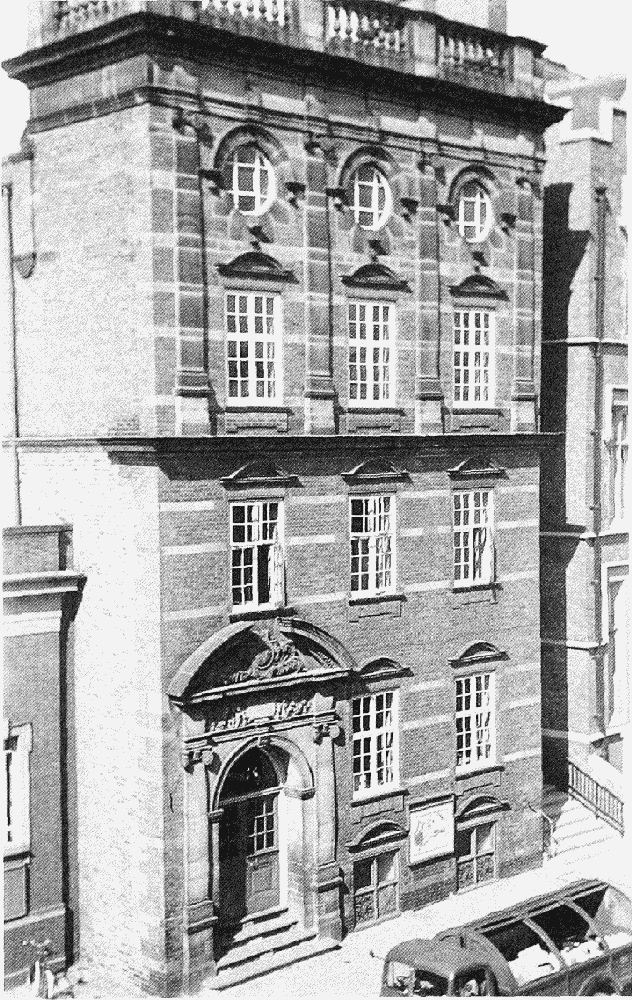A History of the County of Chester: Volume 5 Part 2, the City of Chester: Culture, Buildings, Institutions. Originally published by Victoria County History, London, 2005.
This free content was digitised by double rekeying. All rights reserved.
'Leisure and culture: Libraries', in A History of the County of Chester: Volume 5 Part 2, the City of Chester: Culture, Buildings, Institutions, (London, 2005) pp. 293-294. British History Online https://www.british-history.ac.uk/vch/ches/vol5/pt2/pp293-294 [accessed 19 April 2024]
LIBRARIES
Subscribers to an intended circulating library obtained permission to use a room in the Exchange in 1773, (fn. 1) but it is not certain that the venture was ever launched, and the earliest such library known to have operated had premises in Bridge Street in 1787. (fn. 2) In the early 19th century Chester boasted several small libraries, the most important of which was the City or Public library, owned by 120 proprietors, which began in premises in Whitefriars and moved to rooms over the Commercial News Room in St. Peter's churchyard in 1815. Members paid a high entrance fee and an annual subscription. (fn. 3) The others were circulating libraries run by or associated with booksellers, (fn. 4) one of which was the General Public library, opened in 1817 and connected with the newspaper proprietor John Fletcher. (fn. 5) Similar circulating libraries in the later 19th century included J. W. Huke's in Eastgate Buildings in the 1890s. (fn. 6)
Chester was a latecomer to the movement for working men's education. The Chester Mechanics' Institution was set up in 1835 in Goss Street. (fn. 7) The books and fixtures of the General library were bought with money advanced by William Wardell, and other donations brought the stock to 1,500 volumes, mostly nonfiction, by the end of 1835. (fn. 8) Evening classes were held for architectural, mechanical, and landscape drawing, music, foreign languages, elementary arithmetic, and literacy. (fn. 9)
In 1845 the Institution moved to rented premises in St. John Street, which it bought in 1856, (fn. 10) and in the following year it bought the stock of the City library. (fn. 11) From the late 1850s its educational activities began to fade; members preferred to read for amusement, and the library therefore bought more popular books. (fn. 12) Membership was never more than a few hundred, and the annual subscription of 10s. restricted it to the skilled working and lower middle classes. (fn. 13) The Institution was dogged by financial difficulties and survived only through philanthropic donations; in 1867 the management passed to trustees. (fn. 14)
At the suggestion of E. G. Salisbury, a former M.P. for Chester, the Mechanics' Institution was taken over by the city council in 1875 and converted into a free library under the Free Libraries Act of 1855. (fn. 15) Its opening was delayed by conveyancing problems and the need for repairs. (fn. 16) A periodicals reading room and the lending library were opened in 1877, (fn. 17) the latter largely restocked with novels, travel, history, and biography. (fn. 18) A reference room on the top floor was opened in 1883. (fn. 19) For the 1887 Jubilee T. M. Lockwood designed a new reading room in the garden behind the library and remodelled the front in a classical style with pilasters. The cost of the enlargement was met by William Brown, of Chester's leading department store, who chaired the council's library committee from 1880 to 1900. (fn. 20) A separate reading room for ladies was opened in 1890. (fn. 21) In 1896 there was a short-lived and radical experiment to allow readers behind the librarian's counter to select their own books. (fn. 22)

Public library, St. John Street, 1964
The library also stored books owned by local societies and professional associations, (fn. 23) and let rooms to debating and learned societies for lectures and meetings. (fn. 24) When the School of Science and Art was established in the Grosvenor Museum the library bought books required by students, chiefly on architecture, building, civil and electrical engineering, and chemistry. (fn. 25) It also acted as a depository for course books needed for the Oxford University Extension scheme, launched in Chester in 1887. (fn. 26) The subjects favoured were mostly historical, (fn. 27) and their success inspired the library committee to hold its own evening lectures on similar lines in 1893 and joint lectures with the Oxford scheme in later years. (fn. 28)
The library opened a juvenile department in 1923, (fn. 29) and an extension in 1931, built with the help of the Carnegie Trust, which insisted on closing the separate ladies' reading room. (fn. 30) A branch opened at Blacon in 1937, and in 1954 the Hoole branch library, established in 1951 by the county council, was taken over by the city. (fn. 31) By then the St. John Street building was cramped, and from the 1950s the library committee sought larger premises, but a move was delayed until after the library service passed to the county council in 1974; it took over the former Westminster coachbuilding works in Northgate Street, latterly used as an arts centre, in 1984, creating a purpose-built library behind the distinctive front of the works building. (fn. 32) By then further branch libraries had been opened in Lache, Vicars Cross, and Upton. (fn. 33)
